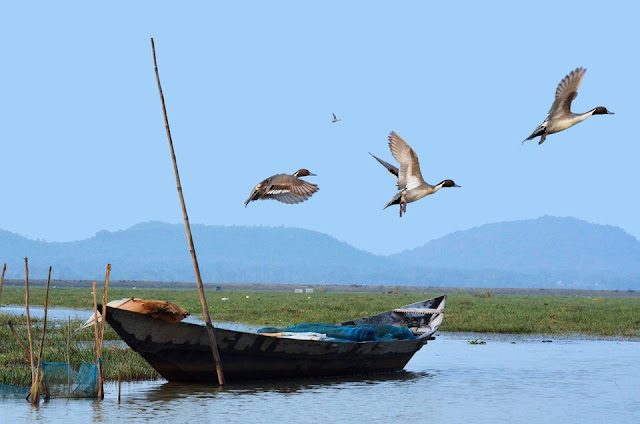While I was making up my mind about visiting Coorg I remember asking a friend what was so special about this hill station in Karanataka. A colleague who hails from Bangalore began enumerating the reasons why I should get myself down to “an astonishing land in the heart of South India” with its “wonderful forests, huge coffee estates, scenic hills, numerous falls, famous temples and trekking places”. The place, he said, was known by various names, like the Scotland of India or the Kashmir of South India, a land of brave soldiers and “a bowl of coffee”. He was quick to add that this was a land inhabited by the most beautiful people and, last but not least, every house in this region had guns — the people worshipped arms.
Those were reasons enough for me to pack my bags and check out what this “bowl of coffee” looked like in reality. Then began the journey — by flight from Delhi to Mangalore and then on to Coorg by road. The first question to the driver sent to meet us at Mangalore airport was how much time would it take to reach Coorg. “Just 131 km, but it takes at least five hours as the roads are ascending, with many curves and turns,” he said. “You will come across picturesque locales, alluring mountains, areca nut trees, coffee plantations and much more.”
Along that never-ending road to Coorg there were coconut and areca nut trees along one side for as far as the eye could see. A few kilometres along the way we came across lush green coffee estates and shimmering streams but the numerous twists and turns served to proved quite exhaustive and it was around 3 pm that we reached the periphery of Coorg.
Coorg or Kodagu isn’t just any town, but the smallest district of Karnataka that shares its border with Kerala. Situated at 1,140 metres above sea level, Virajpet, Medikeri and Pollibetta are the main cities. Because of region’s cold weather, this place was favoured by the British prior to Independence. They compared Coorg with Scotland, as both places enjoy the same hilly terrain and even today one can find imprints of the British Empire in the red-tiled bungalows, for instance, that dot the landscape.
At around 4 pm we reached at our beautiful resort, The Tamara Coorg (Madekeri Taluk), which was to be our home for two days. As I sipped a refreshing welcome drink of lime and mint, sitting in the hut-like reception area, I felt extremely relaxed, an indication of the days to follow.
Tucked away in 170 acres of lush greenery, the resort grows its own coffee, cardamom and pepper, along with several rare plants, and also produces honey. It houses 56 luxury cottages surrounded by hills and sparkling streams. Our cottage was equipped with all the modern amenities — plush four-seater futons, a LED television set, a king-size bed, comfortable lounge chairs, board games for recreation and pull-out mountain view balconies. By the time we settled in, it was almost dark and the manager suggested that we try some fresh coffee and snacks from the coffee shop — The Verandah. He then offered me the chance to drink “my own prepared coffee”. Of course, I agreed. It was next arranged that we visit a coffee estate and see how it was really prepared.
The next morning was the quite mesmerising. For an urban dweller like me, watching rare birds perched atop tall trees in front of my cottage window was a rare treat. They infused a multitude of colours into the surroundings, making for a perfect picture-postcard scene. Our guide for the coffee plantation was a 25-year-old and we wondered how adept he would prove given his age, but he turned out to be an expert — not just on coffee plants but also on cardamom, pepper and other produce. He helped us differentiate between coffee varieties like Arabica and Robusta. Arabica plants are small in height but their beans are larger in size, while Robusta plants are tall but with small beans. He explained how the coffee bean was actually the seed inside a berry that would be dried, roasted and ground before being used as coffee. Our next class was held at the café where he handed us raw coffee beans for us to prepare a brew. It was the best coffee I ever tasted.
No trip is ever complete without tasting the local delicacies and, trust me, Coorg is not only popular for its picturesque beauty but also for its delectable cuisine. They love to celebrate every occasion by drinking alcohol and eating pork. The resort’s executive chef, Ranjan Samal, cooked some of the famous dishes like Pandi curry (pork) and Akki Rotti (a chatpatti-like pancake made from cooked rice and rice flour), as well as Nooputtu (rice) in a multi-cuisine restaurant called The Falls.
Coorg has a basket of sites to visit and after our first-hand experience with coffee, it was time to explore the places nearby. Abbey Falls and Iruppu Falls are the two biggest waterfalls in Coorg but we preferred the latter, near our resort, and its picturesque setting. If one is interested in wildlife, including tiger, jungle bison, sloth bear and the Asiatic elephant, then the Rajiv Gandhi National Park is a good option. The Namdroling Nyingmapa Monastery (Golden Temple) is also very popular among tourists.
Two days of pure bliss later, our final thoughts as we packed our bags was that Coorg was a haven where one could escape from the humdrum of daily life.






























